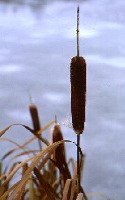View crop
View crop Data sheet EcoPortTypha latifolia
 |
|
| Notes |
|---|
| DESCRIPTION: It is an erect, aquatic, perennial herb reaching 1-3 m in height. Similar to narrow-leaved cattail (Typha angustifolia) but more robust. It spreads extensively by rhizomes so that 3000-4000 m2 may consist of only a few individual plants. It has long, slender, and green stalks topped with brown, fluffy, sausage-shaped flowering heads. Flowering is monoecious, the two portions of the spike are continuous or nearly so. USE: All parts of the plant are edible; the leaves can be used in weaving of mats etc; all parts of the plant have medicinal properties and the plant is used for waste water treatment. GROWING PERIOD: Long-lived perennial. COMMON NAMES: Road-leaved cattail, Reed mace. FURTHER INF: It is a persistent emergent found in almost all wetland plant communities from deep marshes to open bogs, ponds, lakes, slow mowing stream and depressional areas growing on wet substrates and often in 0-30 cm or more of standing water. It can also form floating mats. It is an obligate wetland indicator plant species. It tolerates perennial flooding and reduced soil conditions. In some cases, it can form extensive monotypes that may be considered undesirable because they lack diversity. Its range of adaptability is similar to narrow-leaved cattail, however, it tolerates less salinity, less calcareous waters and is generally occurs on more shallow water. | Sources |
| http://www.npwrc.usgs.gov/resource/1998/mnplant/tyla.htm http://www.ibiblio.org/pfaf/cgi-bin/arr_html?Typha+latifolia&CAN=LATIND |